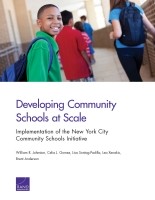| 来源类型 | Research Reports
|
| 规范类型 | 报告
|
| DOI | https://doi.org/10.7249/RR2100
|
| 来源ID | RR-2100-NYCCEO
|
| Developing Community Schools at Scale: Implementation of the New York City Community Schools Initiative |
| William R. Johnston; Celia J. Gomez; Lisa Sontag-Padilla; Lea Xenakis; Brent Anderson
|
| 发表日期 | 2017
|
| 出版年 | 2017
|
| 页码 | 133
|
| 语种 | 英语
|
| 结论 |
Six Core Structures and Services of the NYC-CS Are Being Implemented Across Virtually All Community Schools in the Study- The schools have shown a marked increase over time in the prevalence of these components since the onset of the initiative in 2014.
- There is also substantial variation in the format and degree of program components that schools have in place.
Schools Were More Developed in Their Initiatives Related to Coordination and Connectedness, Compared with Continuous Improvement and Collaboration- The largest share of schools indicated that they were in the "maturing" stage, suggesting schools are progressing toward implementing the full community school model.
- Although the exploratory analysis of the capacity index scores shows variation in schools' development, we found no consistent relationship with structural characteristics such as grade configuration and building colocation status.
- That aspects of schools' cultural climate were positively associated with capacity development.
NYC-CS Is Providing Complementary Supports for the Schools That It Also Designated as Renewal Schools- This is a concurrent school-improvement initiative. Many school leaders expressed optimism about the transformative potential of the community schools approach because it both injects new services into the school setting and changes the social fabric of the school community, for both students and adults.
- Many school leaders said that the programs and services related to the NYC-CS were helpful complements to the academic-oriented supports of the Renewal School Program, in which many of the study schools also participate.
|
| 摘要 |
- To address the challenges relating to alignment and management of multiple program streams for school leaders, the Office of Community Schools, Office of School Health, and other city agencies should align their methods for interacting with and training up school staff. Not only might this help the burden on schools, but it might also lead to stronger connections between the city agencies themselves.
- To address the challenges relating timing of program development and annual program cycles, program implementers at the school and district levels should continue to develop ongoing conversation about timing sensitivities. These conversations could range from school-based strategic planning sessions to map out key dates in the weeks and months ahead, or they could take on a larger view to discuss more initiative-wide issues related to program development and refinement.
- There is a need for a more-focused consideration of city- or district-level strategies and processes that shape the program as a whole and are likely to affect the implementation experiences of schools.
- It is very important to incorporate the voice of families and students in future studies about program implementation and impact.
- Scholars should embark on focused analyses into particular program components.
- The logical next step for this analysis is to involve a shift toward considerations of program impact.
|
| 主题 | Academic Achievement
; After-School Programs
; Disadvantaged Students
; Education Reform
; Educational Program Evaluation
; New York City
|
| URL | https://www.rand.org/pubs/research_reports/RR2100.html
|
| 来源智库 | RAND Corporation (United States)
|
| 引用统计 |
|
| 资源类型 | 智库出版物
|
| 条目标识符 | http://119.78.100.153/handle/2XGU8XDN/108587
|
推荐引用方式
GB/T 7714 |
William R. Johnston,Celia J. Gomez,Lisa Sontag-Padilla,et al. Developing Community Schools at Scale: Implementation of the New York City Community Schools Initiative. 2017.
|
|
文件名:
|
x1507640848345.jpg
|
|
格式:
|
JPEG
|

|
文件名:
|
RAND_RR2100.pdf
|
|
格式:
|
Adobe PDF
|
除非特别说明,本系统中所有内容都受版权保护,并保留所有权利。